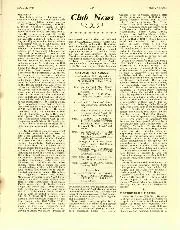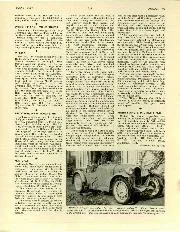

Club News, August 1949
We Hear Lincolnshire seems to harbour early cars, and amongst those reported as seen recently are a Stellite, in daily use, an "11/22" Wolseley two-seater, a G.W.K., a Trojan "Achilles"…
1111-1 II S E liD C !HA IUC IID A
THE American public, we are assured, is ,:n less kindly disposed to novelties than the inhabitants of these islands, and any type of car which demands a new driving technique is apt to be a failure from the sales point of view. The fact that two firms of motor manufacturers market supercharged cars, fitted with open and closed coachwork as part of their standard range, shows how far the supercharger has been developed and recognised in the United States as a trouble-free component, which gives improved performance with no extra complication.
Believing as we do in the future of the supercharged car, we were therefore extremely interested in having a chance to test the Auburn. Before taking the car we were warned that the only car available for test was one which had been in continued use since it had been landed in this country, and which was badly in need of decarbonisation and routine adjustments. Under the circumstances it was to be expected that it would be ten or more m.p.h. below its best form, and some idea of its capabilities was given by a plaque on the dash-board stating that it had exceeded Foo m.p.h. before leaving the United States. However, whatever might be its maximum speed when in good tune, we were at any rate able to satisfy ourselves as to its satisfactory performance as a fast touring car.
Before starting on the road-test proper, mention must be made of the Auburn dualratio back-axle.
Interposed between the crown-wheel and the back-axle is an epicyclic gear-train. When this locked a final drive of 41to i is obtained, but on moving a lever on the steering wheel and depressing the clutch pedal the train is put into operation and the speed of the back-axle is speeded up to give a ratio of equivalent to 3 to 1. The three-speed gear-box works in conjunction with either back-axle ratio, thus providing one set of ratios suitable for traffic use and another intended for fast and economical operation on open roads. The car provided for our use was fitted with a striking-looking two-seater body which suggested speed in every line, but
the large plated outside exhaust-pipes were belied by a quiet purring exhaust note.
Starting off through London traffic we used the lower set of gear-ratios, and found that the engine pulled smoothly almost down to stalling point on the direct ratio, while the easy change-down into second, which is fitted with synchro-mesh mechanism, makes it possible to effect a rapid get-away when required. The clutch was particularly smooth and the pick-up was clean and without any popping back even when starting from cold, and in a word, the car behaved in traffic with the certainty which one associates with the American automobile of to-day. It is, however, on the open road that the Auburn excels. With the high ratio in operation, the engine speed on top gear is only 2,250 r.p.m. at oo m.p.h., and the car glides along with hardly a murmer from under the bonnet right up to its maximum speed. At low speeds this high-gear feeling is almost uncanny, and as the cata
brought into action by moving the steering wheel and depressing the clutch. A slight “clorik” from the rear then proclaims that
the epicyclic :gear has been locked. At 4,000 r.p.m. Speeds on top and third are 7t and 42 m.p.h. respectively.
The 3 to t gear-ratio made possible by the two-speed back-axle undoubtedly reduces engine wear and noise, and the petrol consumption at fast touring speeds does not exceed z5 m.p.g. The same result might equally well baVe been obtained by using a four-speed :gear-box with an over-top, but four forward ratios are almost an unheardof thing in America at the present time. A step up in the Lack-axle is probable a more silent arrangement than a train of gears in the box, and certainly the arrangement adopted on the Auburn is particularly good in this respect, while the engine is flexible enough not to call for a fourth speed.
As is usual on American -cars, the steering is low-geared, but is firm and free from back-lash. It behaves well at speed on straight roads, and after a corner the caster action centres the steering without effort on the driver’s part. On twisty roads or when manoauvring in the garage, of course, a certain amount of wheel-twisting has to be done.
Much the same remarks apply to the suspension. At speed on the straight the springing is most comfortable, being free from either harshness or pitching, and the car can be taken round fast bends without roll, and holding an accurate course. As is often the ease with cars fitted only with hydraulic shock-absorbers, however, the Auburn heels over on sham corners or hair-pins taken sports-car fashion, and friction shock-absorbers, preferably of the type controlled from the dash-hoard Would he useful if much speedwork on winding roads were contemplated. As will have been gathered from what has already been said, the car under test is capable of maintaining a fine average speed. This was partly due to the powerful hydraulic brakes, which were capable of bringing the car to rest in 5o feet from 40 m.p.h. When applied with full force they tended to lock the back wheels, but
being progressive in action they could be used to give just the amount of stopping power required.
Unfortunately., beyond checking the speedometer, we were unable to carry out any tests of the speed or the acceleration in the gears, but these will be obtained and published in next month’s issue of MoTott SPORT.
No mention has so far been made of the supercharger,as this component functions with the same reliability as the distributor or the water-pump. It is inaudible at all but the highest engine speeds, where a slight ringing sound, hardly distinguishable from the othec sounds of fast travel, can be detected’. It is, Of course, of the centrifugal type, made by Schwitzer Cummins. of Indianapolis, and is stated to blow at 4 lbs., though we should doubt whether the pres sure high as this. It is mounted
Sweeping mudguards and an unusual type of radiator cowling give an individual touch to the front of the Auburn.
vertically on the near Side of the engine and driven through a horizontal shaft and bevel gears from the timing. It runs at six times engine speed, the speeding-up being carried out by means of rollers which give the effect of :a friction drive. A water jacket connected with the engine supply ensures quick warming-up, and the downdraft carburetter is mounted directly on the casing.
Apart from the special features already noted, the chassis specification follows normal American practise: The engine is an eight-cylinder Lycoming, with side-byside valves. An aluminium cylinder-head is used, with 14mm. plugs, the ignition being by coil. The carburetter is supplied from the 18 gallon rear tank by means of a mechanical petrol pump, and the car runs on any brand of No. t petrol. The crankshaft is carried in five main bearings, and the oil is purified by being passed through an external filter. The gear box is in unit with the engine, driven through a single-dry-plate clutch, and has
three forward speeds and reverse, synchromesh mechanism being used for top And second. The propellor shaft has two needle-bearing universal joints, and the back-axle is driven through spiral-bevel gears with the dual ratio device incorporated in the crown wheel. The actual change of ratio is brought about by means of a vacuum servo cylinder.
The Chassis side-members are of boxsection and the frame is braced in the centre with a re-inforced X member. Long half-elliptic springs are used, and the shackles have rubber bushes. Hydraulic shock-absorbers are actuated On the Lockhead hydraulic system. The long sweeping lines of the twoseater are most attractive without .being in any way matt& The panels and wings were finished in black cellulose, with red leather upholstery. A single wide front seat is used, and the body sides are carried
high enough to afford good protection. No dickey seat was fitted, but there is room for the spore wheel and a small amount of luggage in the tapering tail. The hood folds down into the body behind the seat, and is rather difficult to erect. In the raised position it gives ample head-room without spoiling the lines of the car, and is quite stormproof with the side-curtains in place.
The Supercharged Auburn may thus be regarded as a fast touring car of real merit, well found and unusually comfortable to drive over long distances. Furthermore, when its engine is developing its full rated output of 150 h.p. it should approach closely if not exceed the Hundred Miles an Hour mark, while its solid construction should ensure a long and useful life. The car was lent to us through the courtesy of Messrs. Clifford Taylor, of 36, Bruton Street, W.r, who are the concessionaires for Groat Britain and Northern Ireland. and open and closed models are available for test at this address. logue quite truthfully remarks, at speeds around thirty miles an hour one might fancy the car were coasting in neutral. The driving position is excellent, with ample leg-room for a six-foot driver and with the steering wheel, gearLlever and other control comfortably within reach, and for fast main-road travel one could scarcely imagine
a more restful means of transport. A minor criticism is that the brake-lever might have been brought closer to hand. It is only used, of course, for parking purposes. The car cruised happily at anything between 4o m.p.h. and 75 m.p.h. on the high top gear, and in fact up to the maximum when road conditions permitted it. The higher the speed the better we liked it, in fact, as the three to one ratio seems rather to stifle the performance under so m.p.h., 65 m.p.h. can be reached on the second gear of the high ratios, though the engine seemed a little fussy. Alternately use can be inade of the lower ratios, which are
A SUCCESSFUL APPLICATION OF FORCED INDUCTION TO THE FAST TOURING CAR